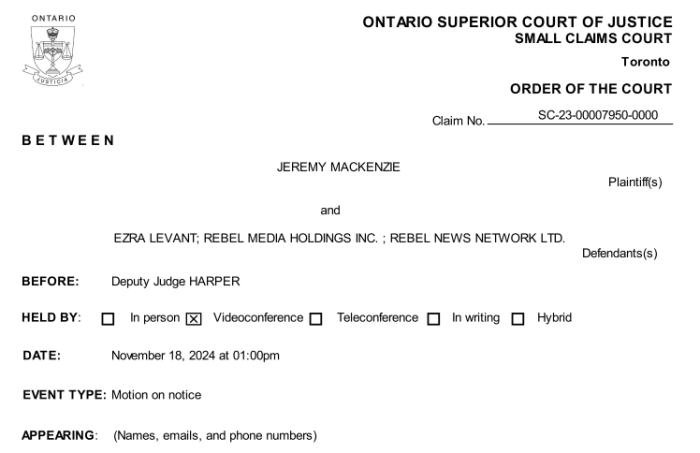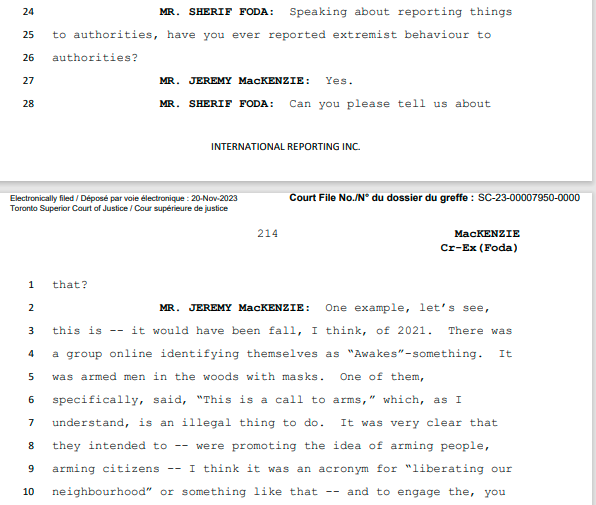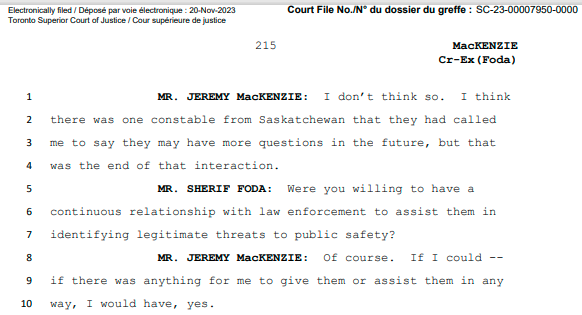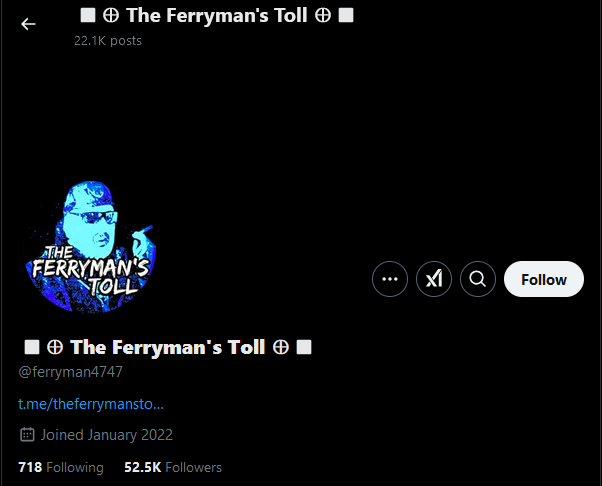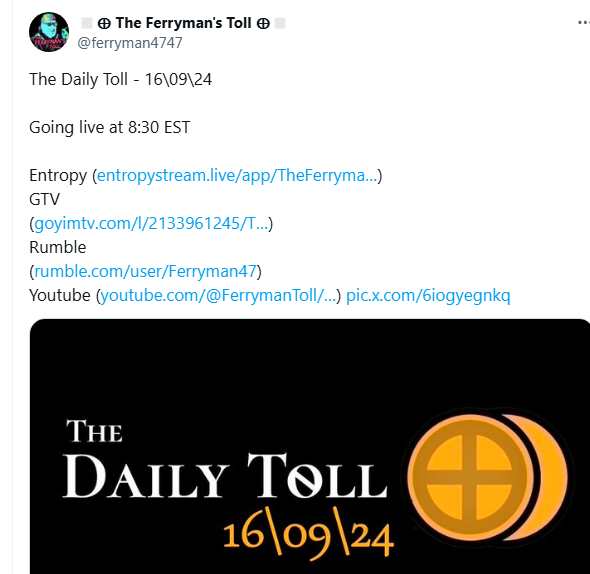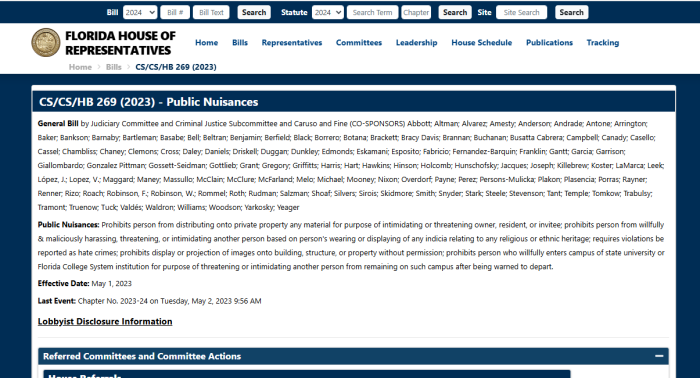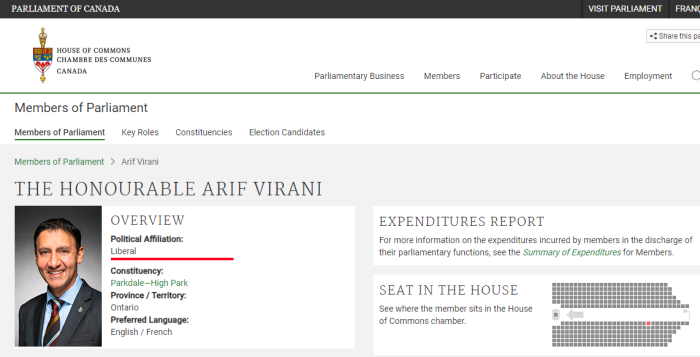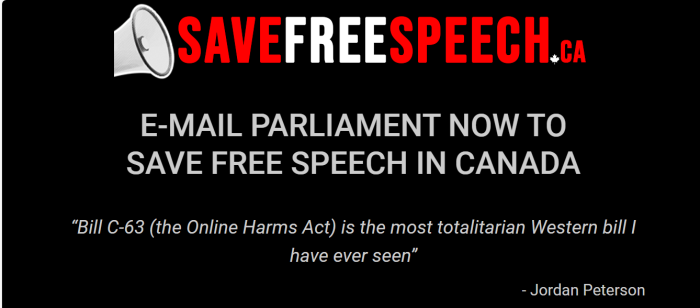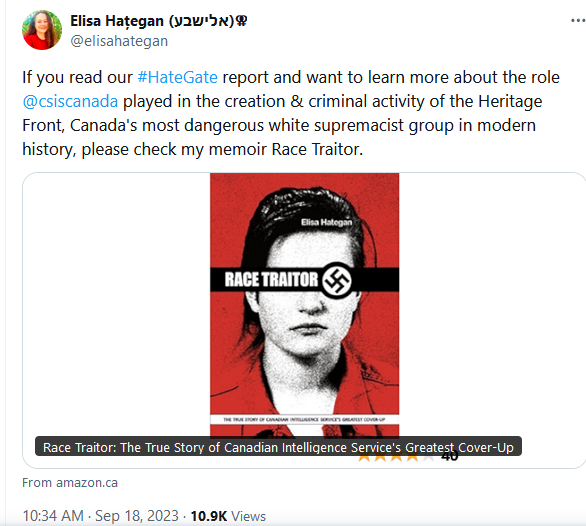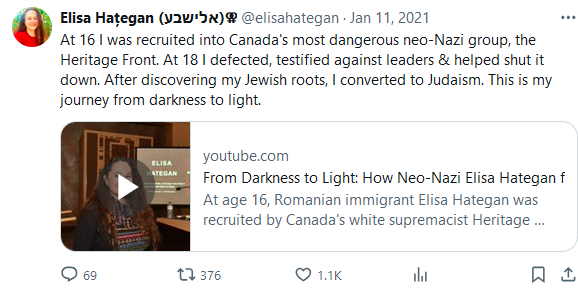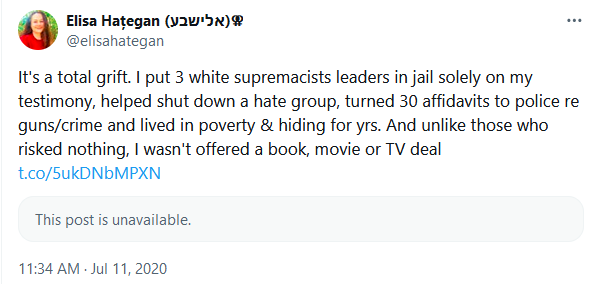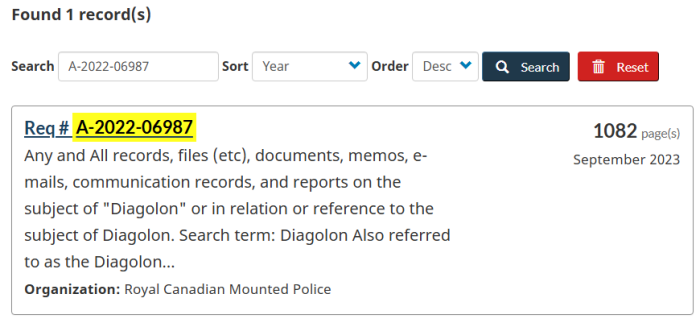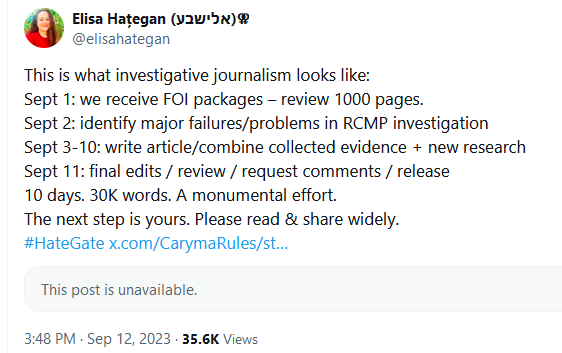
This is to follow up on a story that broke over 3 years ago.
It’s been long established that Jeremy MacKenzie (a.k.a. Raging Dissident) called the police on a group named “Liberate Your Neighbourhood”, and a member, Landon Preik. This happened while lockdowns were being enforced all over the country. It’s what he swore to under oath.
MacKenzie has repeatedly bragged — such as on Red Ice — that he contacted the RCMP because he viewed the group as a threat to public safety. It’s portrayed as civic necessity, and done to prevent violence. Rightly or wrongly, he has been labelled a “fed” and a “rat” for doing this.
Thing is, his version of events doesn’t add up. There is a much more plausible reason for MacKenzie contacting the police, namely to get himself out of his own gun charges. After all, Preik was arrested less than 2 days after he was.
The whole “HateGate” narrative never made sense in this regard either. If the authorities were looking for an excuse to invoke the Emergencies Act, MacKenzie would have given them a legitimate one. Why then would they frame him for it, if he was cooperative with police?
The Global News article on the case is dated February 3rd, 2022. It references a police investigation that began on September 14th, 2021. (See archive). The problem is that it lacks sufficient information about the case.
However, after ordering some court documents, things become a lot clearer.
MacKenzie’s Arrest/Residential Search January 26th, 2022
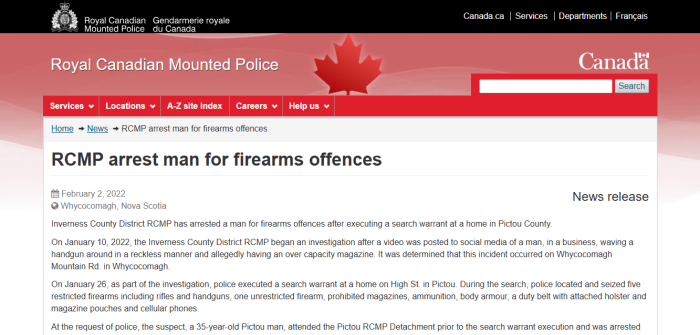
Inverness County District RCMP has arrested a man for firearms offences after executing a search warrant at a home in Pictou County.
On January 10, 2022, the Inverness County District RCMP began an investigation after a video was posted to social media of a man, in a business, waving a handgun around in a reckless manner and allegedly having an over capacity magazine. It was determined that this incident occurred on Whycocomagh Mountain Rd. in Whycocomagh.
On January 26, as part of the investigation, police executed a search warrant at a home on High St. in Pictou. During the search, police located and seized five restricted firearms including rifles and handguns, one unrestricted firearm, prohibited magazines, ammunition, body armour, a duty belt with attached holster and magazine pouches and cellular phones.
At the request of police, the suspect, a 35-year-old Pictou man, attended the Pictou RCMP Detachment prior to the search warrant execution and was arrested without incident. He was later released on conditions, which include that he not possess any firearms, weapons, ammunition or explosive substances. He will be facing charges of Careless Use of a Firearm, Unauthorized Possession of a Prohibited Device, Possession of a Prohibited Device Knowing It’s Possession is Unauthorized, Possession of a Firearm at an Unauthorized Place. He will appear in Port Hawkesbury Provincial Court on May 30, 2022.
File #: 2022-39074
Why does the January 26th, 2022 date matter? It’s because of what happened in the immediate aftermath.
MacKenzie was released, and headed to the convoy. Preik was picked up the next day.
Preik Picked Up January 27th, 2022 On Possession Charges
The information about the case is available, and it spells out exactly what he has been charged with. Interestingly, it lists both September and November 2021 dates.
Originally, there were 6 charges. It was later amended to 10.
- Section 91(1) Possession of prohibited weapon: Armi Jager AP80 semi-automatic rifle
- Section 91(1) Possession of prohibited weapon: CZ-CZ858 Tactical 2 semi-automatic rifle
- Section 91(2) Possession of prohibited devices: 5 handgun magazines, with 15 cartridge capacity
- Section 91(2) Possession of prohibited devices: 4 CZ magazines, with 30 cartridge capacity
- Section 91(2) Possession of prohibited devices: 1 CZ detachable magazine, with 30 cartridge capacity
- Section 86(1) Reckless transportation/storage: Rossi Ranch Hand Rifle
- Section 86(1) Reckless transportation/storage: K100 Dynamic Handgun
- Section 86(1) Reckless transportation/storage: CZ VZ58 Sporster semi-automatic rifle
- Section 86(1) Reckless transportation/storage: Mossberg shotgun
- Section 86(1) Reckless transportation/storage: CZ 75 Luger semi-automatic handgun
Notice what’s missing? Preik was never charged with terrorism, treason, sedition, or any violent offence. The complaint against him is solely for possession and transport/storage offences.
That is, of course, not to say that the current charges won’t mess up his life.
Are we supposed to believe that the RCMP took MacKenzie’s information and did nothing with it for months? And is it just a coincidence that they only acted after the raid in Pictou? It strains all credulity to accept such a narrative, but here we are.
MacKenzie: Contacting RCMP Necessary To Prevent Violence
Almost everyone by now is familiar with this clip.
At his POEC testimony MacKenzie specifically named “Liberate Your Neighbourhood” as a group that he turned into police. He said there was a group of men “with masks and guns, saying ‘this is a call to arms'”. It’s portrayed as a necessary act in order to protect public safety.
He also says that this happened in the Fall of 2021.
Again, the timeline doesn’t make sense, if MacKenzie is to be believed. While it seems true that he did contact the police, the sequence of events is very different. His version is quite implausible, and we’ll go through it.
Perhaps he had “more information” to share in January 2022.
Timeline Of Major Events For Preik And MacKenzie
September 14th, 2021: RCMP begins investigating a group called “Liberate Your Neighbourhood”, based on videos that had been posted online.
September 23rd, 2021: Preik interviewed by RCMP for first time.
September 29th, 2021: Preik interviewed by RCMP for second time.
November 2nd, 2021: Preik interviewed by RCMP for third time.
To make this clear, the police are obviously aware of who Preik is, having talked to him on 3 separate occasions. However, there will be no arrest for months. One has to wonder why. MacKenzie (supposedly) telling them about the videos wasn’t enough, but something would change.
January 10th, 2022: RCMP becomes aware of a video of MacKenzie (and another man), in possession of firearms, and would later accuse them of using them carelessly.
January 13th, 2022: According to the ITO (page 5) MacKenzie admitted to police that he was intoxicated when this happened.
January 22, 2022: RCMP applies for a search warrant for MacKenzie’s Pictou home for:
- Smith & Wesson M&P 9 firearm
- Glock 17 firearm
- High capacity magazine
- Gun holster
- Firearms registration paperwork
- MacKenzie’s cell phone (unknown brand)
January 25th, 2022: This is the first day that (if authorized) the search warrant would allow the police into MacKenzie’s home.
January 26th, 2022: RCMP raid MacKenzie’s home in Pictou, N.S., and file firearms charges. From the way the press release is worded, it sounds like he was released almost right away.
January 27th, 2022: Preik is arrested in Chilliwack, B.C.
January 28th, 2022: Preik is released without bail, while facing 6 charges.
February 3rd, 2022: Global News publishes arrest of Preik. It was noted that he faced (a) five counts of careless use or storage of a firearm, and (b) one count of possession of a prohibited weapon. The article only specifies that an investigation had been ongoing since September 14th, 2021.
August 2nd, 2022: Preik now facing a total of 10 charges. His release conditions are modified to require that he pay $200 if he breaches them.
December 8th, 2022: Preik appears in court on a further modified complaint.
January 27th, 2023: Crown elects to proceed by indictment (the more serious option)
September 6th, 2024: After voir dire hearing, it’s ruled that Preik’s 3 interrogations (September 23rd, 29th, and November 2nd of 2021) are all admissible as evidence. See page 5.
Preik faces trial later this year, while MacKenzie had all of his charges thrown out.
Why Does Any Of This Matter?
MacKenzie has long stated that he turned in the group to avoid violent (armed) confrontation with the state. While difficult to swallow for many, it’s at least a plausible excuse to send the RCMP after someone. Regardless of one’s personal feelings, there’s a justification to do this.
That justification disappears once you look when things happened.
Preik had been interviewed at least 3 times by police in late 2021. They clearly knew who he was, but chose not to make any arrest then. In fact, they only acted just a day or so after MacKenzie was picked up in Nova Scotia.
It’s unrealistic to assume police simply ignored specific allegations about an armed militia (as MacKenzie made) for several months. But we’re supposed to believe that arrest came just after his…. and it’s entirely a coincidence.
Did MacKenzie call the RCMP to inform them about a violent threat?
Or did he do it to get himself released from prison?
And what’s the deal with his “continuous relationship” with law enforcement? Diagolon isn’t an entrapment operation, is it?
PREIK COURT DOCUMENTS:
(1) Preik Record Of Proceeding
(2) Preik Information
(3) Preik Release
(4) Preik Transcript January 28 2022
(5) Preik Transcript January 28 2022 Copy
(6) Preik Transcript August 2 2022
(7) Preik Transcript August 2 2022 Copy
(8) Preik Transcript January 27 2023 Elect Method
(9) Preik Transcript August 15 2024 Not Guilty Plea
MEDIA ATTENTION:
(1) https://globalnews.ca/news/8591403/rcmp-seize-firearms-in-b-c-following-probe-into-video-by-self-described-militia/
(2) Preik Arrest Global News Announcement
(3) https://www.rcmp-grc.gc.ca/en/news/2022/rcmp-arrest-man-firearms-offences
(4) RCMP arrest man for firearms offences
(5) https://www.antihate.ca/jeremy_raging_dissident_mackenzie_arrested_waving_handgun_local_business
SEARCH WARRANT FOR MACKENZIE:
(1) ITO Warrant Application For Jeremy MacKenzie January 22 2022



